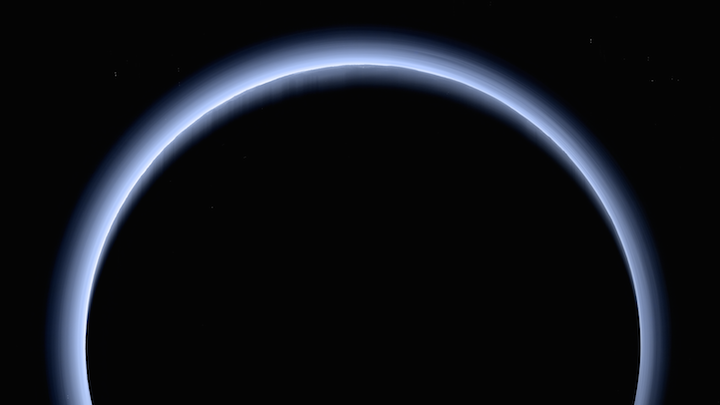
It’s taken a year and a half, but the International Astronomical Union and the science team behind NASA’s New Horizons mission have finally struck a deal for naming the features on Pluto and its moons.
The agreement, announced today, will open the way for the already well-known “informal” names for places on Pluto, such as Tombaugh Regio and Sputnik Planum, to become formal.
It also allows for features on Charon, Pluto’s biggest moon, to be officially associated with fictional characters and locales – including Mordor from “Lord of the Rings,” Mr. Spock from “Star Trek” and Princess Leia from “Star Wars.”
The scheme is mostly based on names that were suggested even before New Horizons flew past Pluto on July 14, 2015, as part of the SETI Institute’s “Our Pluto” campaign.
The IAU and the New Horizons team agreed on a few tweaks to the categories for Pluto and Charon. For example, the revised scheme allows for naming places on Pluto after pioneering space missions and spacecraft, and naming features on Charon after authors and artists associated with space exploration.
Back in 2015, the IAU wasn’t willing to go along with those themes, because they were similar to themes used for Mercury, Venus and Mars. The revised scheme means that Sputnik Planum – the informal name for the bright left half of Pluto’s “heart” – and Kubrick Mons on Charon are more likely to be OK’d.
Now the New Horizons team will go ahead and submit its dozens of informal names for the IAU’s approval, in accordance with the international body’s longstanding procedures.


Some of the scientists on the New Horizons mission, including principal investigator Alan Stern, haven’t always gotten along with the IAU, which engineered the reclassification of Pluto as a dwarf planet in 2006. But today, both sides had good things to say about each other.
Previously: Pluto, we have a problem … some names may not fly on official maps
“I’m very happy with both the process and partnership that New Horizons and the IAU undertook that led to wonderful, inspiring and engaging naming themes for surface features on Pluto and its moons,” Stern said in today’s announcement.
The IAU’s Working Group for Planetary System Nomenclature will work with Stern and his colleagues to sign off on the formal names.
“I am very pleased that the close collaboration of the WGPSN with the New Horizons Team led to these beautiful, inspirational categories for naming the features on Pluto and its satellites,” said Rita Schulz, who’s in charge of the working group. “We are ready now for receiving the proposals for names. Good things take time, but it will be worth it.”
Here are the naming themes that have been approved for Pluto and its moons:
Pluto
- Gods, goddesses and other beings associated with the underworld from mythology, folklore and literature
- Names for the underworld and for underworld locales from mythology, folklore and literature
- Heroes and other explorers of the underworld
- Scientists and engineers associated with Pluto and the Kuiper Belt
- Pioneering space missions and spacecraft
- Historic pioneers who crossed new horizons in the exploration of the Earth, sea and sky
Charon
- Destinations and milestones of fictional space and other exploration
- Fictional and mythological vessels of space and other exploration
- Fictional and mythological voyagers, travelers and explorers
- Authors and artists associated with space exploration, especially Pluto and the Kuiper Belt
Themes for Pluto’s smaller moons are:
- Styx: River gods
- Nix: Deities of the night
- Kerberos: Dogs from literature, mythology and history
- Hydra: Legendary serpents and dragons
The agreement means that some of the thousands of names that were suggested and voted on during the “Our Pluto” campaign could soon start appearing on official planetary maps.
“Imagine the thrill of seeing your name suggestion on a future map of Pluto and its moons,” said Jim Green, director of NASA’s Planetary Science Division. “Months after the Pluto flyby, the New Horizons mission continues to engage and inspire.”
New Horizons is now on its way to an encounter in 2019 with yet another icy objectin the Kuiper Belt, currently known as 2014 MU69. Someday, that mini-world and its features will have to be given official names as well. Any suggestions?
Quelle: GeekWire
-
Update: 26.02.2017
.
Frams: Flight over Charon
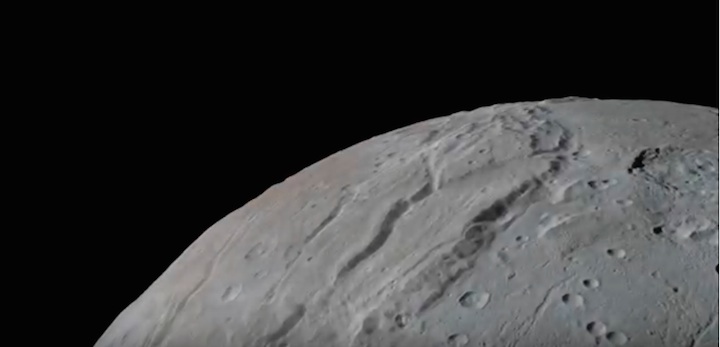
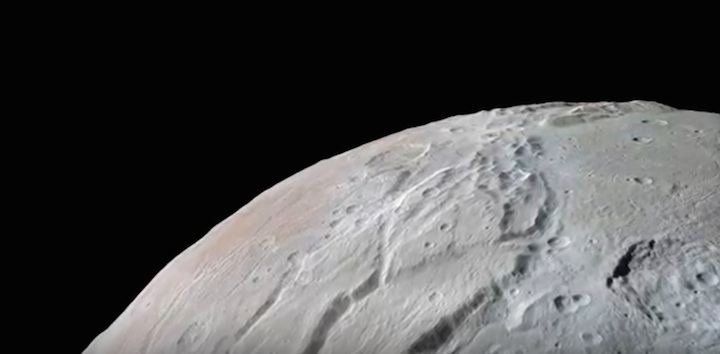
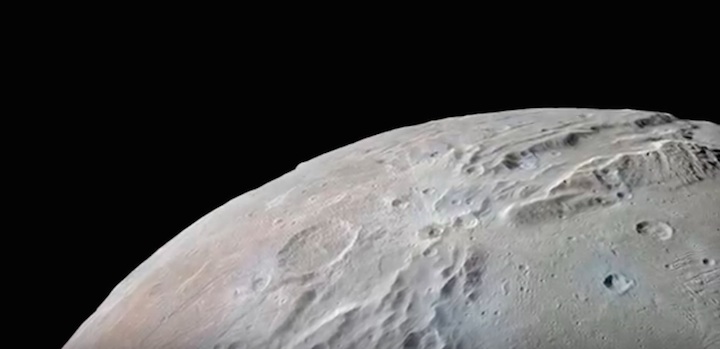
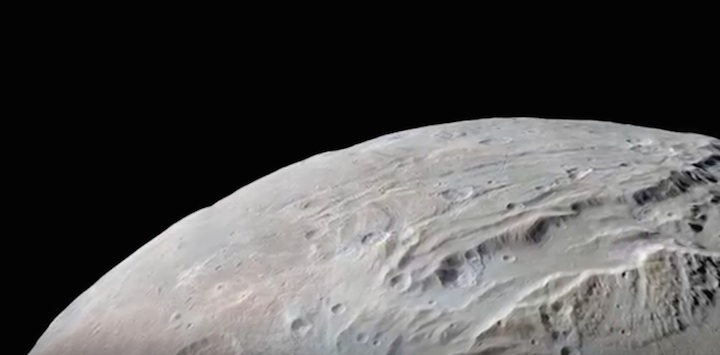
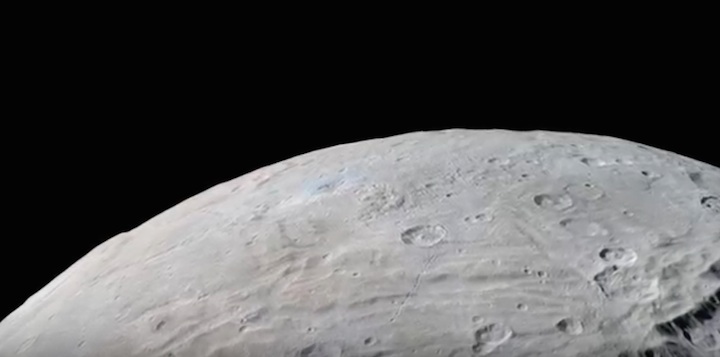
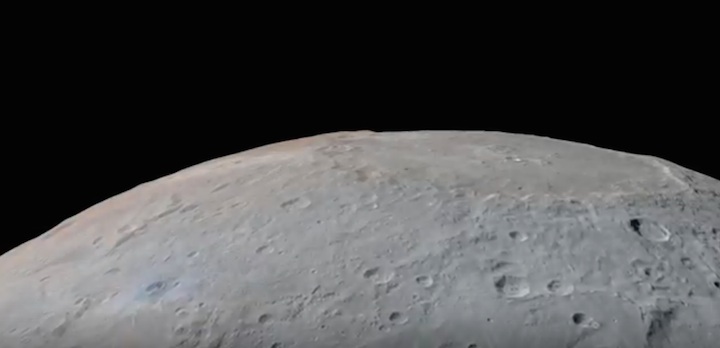
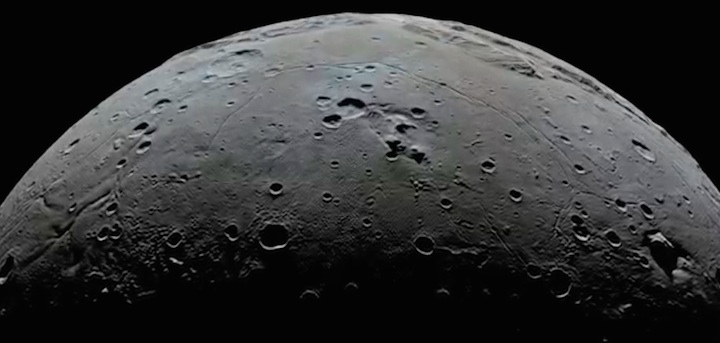
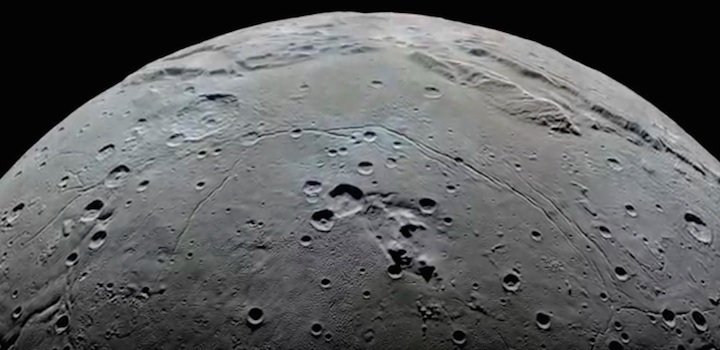
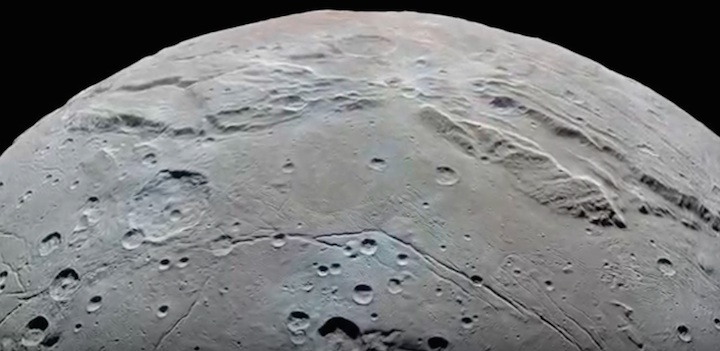
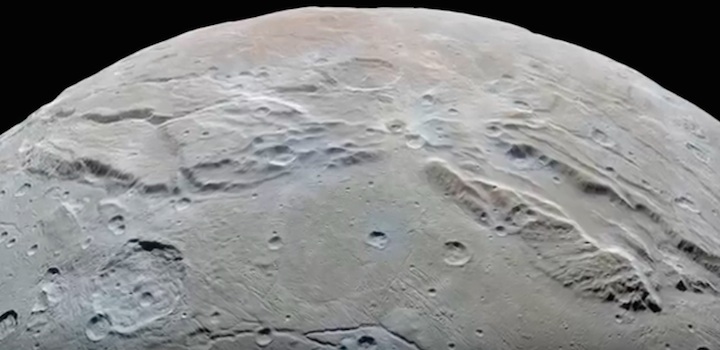
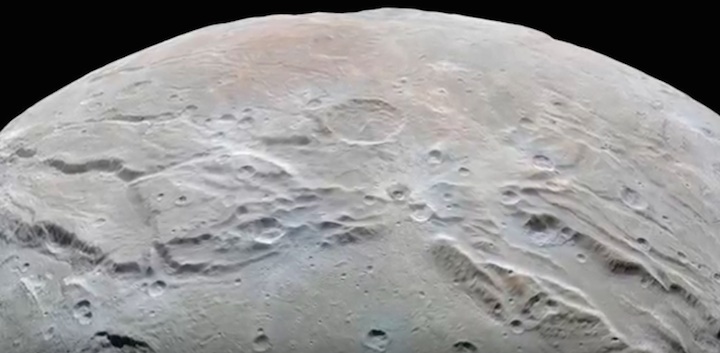
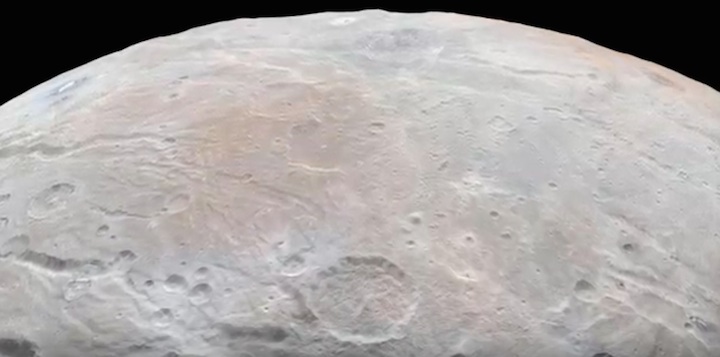
Quelle: NASA
---
Update: 26.03.2017
.
This blue-sky image of Pluto is absolutely stunning
Pluto’s surface features become clear at the terminator, under the twilight Sun.
Even though all of the New Horizons spacecraft data taken during its 2015 flyby of Pluto has been downloaded to Earth for months, scientists are still piecing it all together. Now two scientists, Tod Lauer and Alex Parker, have processed some of the New Horizons data to produce a stunning look back at the dwarf planet.
This departure shot was constructed from a mosaic of six black-and-white images captured by New Horizons' Long Range Reconnaissance Imager as the spacecraft moved away from Pluto. Color has been added from a lower resolution Ralph/Multispectral Visible Imaging Camera. At the time the pictures were taken, New Horizons was only about 200,000km away from Pluto, or about 3.5 hours after the closest approach on July 14, 2015. The resolution of the images stitched together is about 1km per pixel.
In this composite photo, Pluto is illuminated from behind by the Sun, almost as if the world is producing an annular eclipse for New Horizons. The image showcases a beautiful blue "haze" which, according to planetary scientists, is smog produced by sunlight interacting with methane and other molecules in Pluto's atmosphere. These larger molecules scatter blue sunlight.
When expanded to full size, Pluto's surface features become clear at the terminator, and the twilight Sun casts shadows around mountains. This is an amazing, evocative view of a world we hardly knew just two years ago.
Quelle: ars technica
---
Update: 5.04.2017
.
New Horizons Halfway from Pluto to Next Flyby Target
How time and our spacecraft fly – especially when you're making history at 32,000 miles per hour.

A KBO among the Stars: In preparation for the New Horizons flyby of 2014 MU69 on Jan. 1, 2019, the spacecraft’s Long Range Reconnaissance Imager (LORRI) took a series of 10-second exposures of the background star field near the location of its target Kuiper Belt object (KBO). This composite image is made from 45 of these 10-second exposures taken on Jan. 28, 2017. The yellow diamond marks the predicted location of MU69 on approach, but the KBO itself was too far from the spacecraft (544 million miles, or 877 million kilometers) even for LORRI’s telescopic “eye” to detect. New Horizons expects to start seeing MU69 with LORRI in September of 2018 – and the team will use these newly acquired images of the background field to help prepare for that search on approach.
Credits: NASA/Johns Hopkins University Applied Physics Laboratory/Southwest Research Institute
Continuing on its path through the outer regions of the solar system, NASA's New Horizons spacecraft has now traveled half the distance from Pluto – its storied first target – to 2014 MU69, the Kuiper Belt object (KBO) it will fly past on Jan. 1, 2019. The spacecraft reached that milestone at midnight (UTC) on April 3 – or 8 p.m. ET on April 2 – when it was 486.19 million miles (782.45 million kilometers) beyond Pluto and the same distance from MU69.
"It's fantastic to have completed half the journey to our next flyby; that flyby will set the record for the most distant world ever explored in the history of civilization,” said Alan Stern, New Horizons principal investigator from the Southwest Research Institute in Boulder, Colorado.
Later this week – at 21:24 UTC (or 5:24 p.m. ET) on April 7 – New Horizons will also reach the halfway point in time between closest approaches to Pluto, which occurred at 7:48 a.m. ET on July 14, 2015, and MU69, predicted for 2 a.m. ET on New Year's Day 2019. The nearly five-day difference between the halfway markers of distance and time is due to the gravitational tug of the sun. The spacecraft is actually getting slightly slower as it pulls away from the sun's gravity, so the spacecraft crosses the midpoint in distance a bit before it passes the midpoint in time.
Ready for a Rest
New Horizons will begin a new period of hibernation later this week. In fact, the spacecraft will be sleeping through the April 7 halfway timing marker to MU69, because mission operators at the Johns Hopkins Applied Physics Laboratory (APL) in Laurel, Maryland, will have put the spacecraft into hibernation two hours beforehand.
The scheduled 157-day hibernation is well-deserved; New Horizons has been "awake” for almost two and a half years, since Dec. 6, 2014. Since then, in addition to its historic Pluto encounter and 16 subsequent months of relaying the data from that encounter back to Earth, New Horizons has made breakthrough, distant observations of a dozen Kuiper Belt objects (KBOs), collected unique data on the dust and charged-particle environment of the Kuiper Belt, and studied the hydrogen gas that permeates the vast space surrounding the sun, called the heliosphere.
"The January 2019 MU69 flyby is the next big event for us, but New Horizons is truly a mission to more broadly explore the Kuiper Belt,” said Hal Weaver, New Horizons project scientist from APL, in Laurel, Maryland. "In addition to MU69, we plan to study more than two-dozen other KBOs in the distance and measure the charged particle and dust environment all the way across the Kuiper Belt.” New Horizons is currently 3.5 billion miles (5.7 billion kilometers) from Earth; at that distance, a radio signal sent from the operations team – and traveling at light speed – needs about five hours and 20 minutes to reach the spacecraft. All spacecraft systems are healthy and operating normally, and the spacecraft is on course for its MU69 flyby.
Quelle: NASA
---
Update: 12.04.2017
.
RIT scientist measures brightness of the universe with NASA’s New Horizons spacecraft
Planetary mission offers up-close view of Cosmic Optical Background
In the study, “Measurement of the Cosmic Optical Background using the Long Range Reconnaissance Imager on New Horizons,” lead author Michael Zemcov used archival data from the instrument onboard New Horizons—the Long Range Reconnaissance Imager, or LORRI—to measure visible light from other galaxies. The light shining beyond the Milky Way is known as the cosmic optical background. Zemcov’s findings give an upper limit to the amount of light in the cosmic optical background.
“Determining how much light comes from all the galaxies beyond our own Milky Way galaxy has been a stubborn challenge in observational astrophysics,” said Zemcov, assistant professor in RIT’s School of Physics and Astronomy and member of RIT’s Center for Detectors and Future Photon Initiative.
Light from the cosmic optical background can reveal the number and location of stars, how galaxies work and give insights into the peculiar nature of exotic physical processes, such as light that may be produced when dark matter decays. Dark matter is the invisible substance thought to comprise 85 percent of matter in the universe.
“This result shows some of the promise of doing astronomy from the outer solar system,” Zemcov said. “What we’re seeing is that the optical background is completely consistent with the light from galaxies and we don’t see a need for a lot of extra brightness; whereas previous measurements from near the Earth need a lot of extra brightness. The study is proof that this kind of measurement is possible from the outer solar system, and that LORRI is capable of doing it.”
Spacecraft in the outer solar system give scientists virtual front-row seats for observing the cosmic optical background. The faint light from distant galaxies is hard to see from the inner solar system because it is polluted by the brightness of sunlight reflected off interplanetary dust in the inner solar system.
Cosmic dust is sooty bits of rock and small debris that moved, over time, from the outer solar system toward the sun. Scientists launching experiments on sounding rockets and satellites must account for the dust that makes the Earth’s atmosphere many times brighter than the cosmic optical background.
NASA’s New Horizons mission has been funded through 2021, and Zemcov is hopeful for the chance to use Long Range Reconnaissance Imager to re-measure the brightness of the cosmic optical background.
“NASA sends missions to the outer solar system once a decade or so,” Zemcov said. “What they send is typically going to planets and the instruments onboard are designed to look at them, not to do astrophysics. Measurements could be designed to optimize this technique while LORRI is still functioning.”
Zemcov’s method harkens back to NASA’s first long distance missions Pioneer 10 and 11 in 1972 and 1974. Light detectors on the instruments measured the brightness of objects outside the Milky Way and made the first direct benchmark of the cosmic optical background.
“With a carefully designed survey, we should be able to produce a definitive measurement of the diffuse light in the local universe and a tight constraint on the light from galaxies in the optical wavebands,” Zemcov said.
Archived data from New Horizon’s Long Range Reconnaissance Imager show “the power of LORRI for precise low-foreground measurements of the cosmic optical background,” Zemcov wrote in the paper.
Chi Nguyen, a Ph.D. student in RIT’s astrophysical sciences and technology program, mined data sets from New Horizons’ 2006 launch, Jupiter fly-by and cruise phase. She isolated four different spots on the sky between Jupiter and Uranus, captured in 2007, 2008 and 2010, that met their criteria: looking away from the solar system and looking out the galaxy.
Poppy Immel, an undergraduate majoring in math and computer science, generated the data cuts and determined the photometric calibration of the instrument. Other co-authors include Asantha Cooray from University of California Irvine; Carey Lisee from Johns Hopkins University; and Andrew Poppe from UC Berkeley. Zemcov is affiliated with the Jet Propulsion Laboratory.



